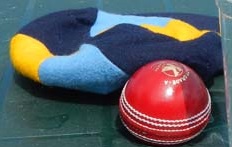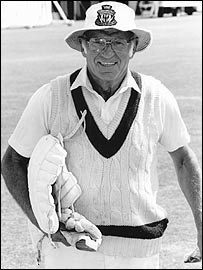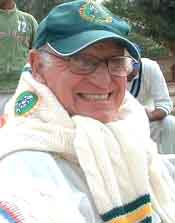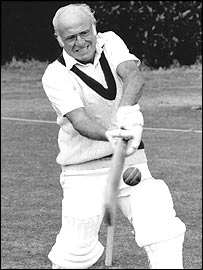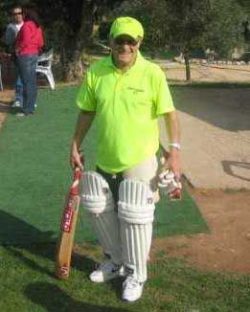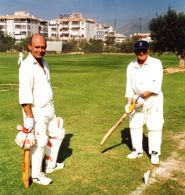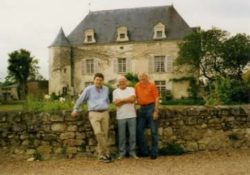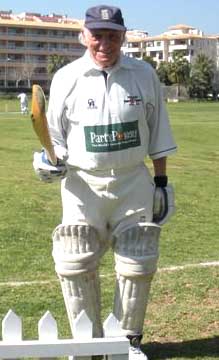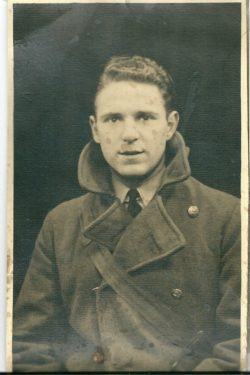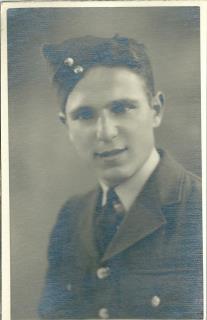John (Jack) Hyams
Jack passed away in his sleep on the night of Wednesday May 2nd 2012. He had fought hard to recover from a series of paralysing strokes suffered in June 2010, a year in which he had played 11 cricket matches for Nomads CC & Billericay Veterans. Sadly he was not to complete his final century but is doubtless ‘netting’ with Bertie Joel in another stratosphere.
The Funeral took place on Wednesday 16th May 2012 at 14:00hrs in Chelmsford Crematorium Essex & afterwards at Billericay Cricket Club
Jack Hyams celebrated his 90th birthday in December 2009. Remarkably included in the celebrations was a weekend cricket tour to Spain to play at the Woodbridge Oval Albir L’Alfas Del Pi against Sporting Alfas CC and a testing net at Ashmole Secondary School indoor sports hall with members of the Bertie Joel Net. Many Nomads partook of both events.
Jack Hyams has played for Cleckheaton, Cockfosters, Finchley, Mill Hill, Cross Arrows, West Bromwich Dartmouth, Forty Club, Club Cricket Conference, Bunburrys, Stoics, Nomads, Cricket World XI, Bertie Joel’s XI, Cheshunt Thursday, Billericay Veterans, Bushmen, Magdala, Ibiza, MCC……….
Jack Hyams scored more runs in club cricket than anyone else in the history of cricket,over 121,000 runs with 176 centuries. He has played in India, Caribbean, South Africa, Australia and New Zealand as well a host of European countries. Four years ago Jack played five matches on the trot for Nomads CC on tour in Spain when that club was short of players.
No player in the history of the game has played so many matches, let alone hit so many runs. No one has scored so many centuries after the age of 60
He was an MCC Senior Coach. He was an ACU & S qualified umpire
Jack was Life President of The Barmy Army and a Life Vice President of Ibiza(Eivissia ) Cricket Club among many others.
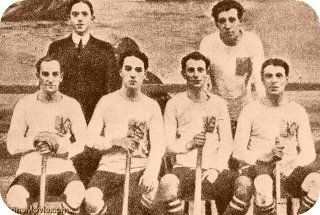
Jack’s mother was French, her father was Paris editor of the American paper Herald Tribune and skipper of the paper’s cricket club which competed in the extensive Paris cricket league before WW1. Jack’s father was for many years a member of Fred Karno’s circus with the stage name of Sinclair. When Karno received an invitation from the fledgling film industry in US, he was sceptical of the moving pictures so sent the unmarried men to America..Charlie Chaplin, Stan Laurel etc.The marrieds stayed at home and Jack’s father left the stage for business. Chaplin visited the Hyams home on visits to uk and met the young J Hyams.
Jack Hyams was offered professional cricket and football terms but when he told his father how much was the wage his father forbade him following a sports career saying I will pay you double and you can give half to your mother.
In WW2 Jack was an aircraft gunner. Of the 17 who joined up with Jack all of them were dead within one year. Jack spent one year as a gunner in aircraft protecting the North Atlantic convoys. Having unusually survived as such a gunner he then spent the rest of WW2 as a PE instructor probably laying the basis for his life long fitness.
Jack in the RAF WW2
After WW2 Jack played professional football for Bradford Park Avenue under the pseudonym of Sinclair his father’s stage name playing in that lowly club’s giant killing defeat of Arsenal in the FA Cup. He played cricket for Cleckheaton in the Bradford League. With the break up of his first marriage Jack returned to London where he joined Cockfosters CC. Subsequently he was to play for Finchley CC and Mill Hill CC as well as MCC and a host of Wandering Clubs. He toured extensively, playing in Barbados, South Africa and India as well as many short tours to Continental Europe.
Playing as a pro for West Bromwich Dartmouth aged 49 he faced Wes Hall and survived.
Jack scored 176 centuries, at least one in 8 decades of his life.
Jack became President of the Barmy Army and was introduced on a Radio Interview in Australia as Club Cricket’s Bradman.
On his last tour with Nomads in Spain March 2010 he finally acknowledged his great age when declaring he was going to go out all night in Benidorm every other night and not every night as he had done before for the preceding 14 years.
Sadly having played some ten games of cricket in 2010 Jack suffered a major stroke in June 2010.
He was back home and fighting to regain his fitness and speech but was in a Care Home-(Eastham Care Home in South Woodham Ferrers). .May 2011.
Jack has a facebook page and there is a Jack Hyams Cricket Club which visit Spain every Autumn http://www.facebook.com/people/Jack-Hyams/1042733214#!/group.php?gid=44603504436
Jack Hyams 64 not out, 1983
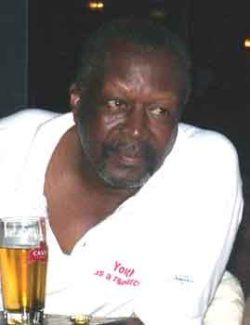
John Nagenda Interview
100,000 not out
They called Bradman the run machine, and he was. At club cricket level dub Jack Hyams the same. He was born one year after the Great War broke out, and he is still alive and playing today, 64 years afterwards. More than that, just last year at Harrow, playing for the XL Club, his throwing in from the boundary, reckless regarding his number of years, and bang into the keeper’s gloves, was a visible and winning challenge against nature. His birthplace was near the Kennington Oval. At the age of 8 he started playing for his school at the smallest level, and was to be captain there, and at the junior and senior levels as well. They used to be taken by tram to Clapham Common for games and practice, not having a ground of their own at the school. Nostalgia by gaslight. He left school at 14 (when I lift an eyebrow he snaps that they all did then, more or less), by which time he had played in a representative game for South London v. East London at the Oval. The highlight he remembers best while at school was making 103 n.o. against Kennington Road School at Clapham Common. It won him a Jack Hobbs bat. He was 12 or 13. After school he played for Kingsbury Town at 15, and played there until war interfered. He made a great number of runs, including about 20 centuries. He then joined the R.A.F., but was not sent overseas, allowing him to play cricket, and soccer, for his station sides. The run-getting did not lessen, and he remembers a number of hundreds. After demob in ’45 he went to play for Cleckheaton in the Bradford League and stayed in Yorkshire two seasons. Then he moved back South and joined Cockfosters in 1947. Most of his playing life has been spent there, except for a break of around 13 years – and how that came about we shall see in due course.
There is no disputing that at Cockfosters Jack was king. In his first game for the 1st XI on Whit Monday ’48 he made 87 in a win over North. Mymms. The next Sunday he cracked 71 out of 115. In July he made 75 n.o. out of 118-8. In reply Mill Hill Village were all out for 24. (Incidentally around this time a team colleague ‘Nobby’ Clarke took his 4000th wicket in 21 years’ cricket for Orpington., Gravesend and Cockfosters. He was 50. He celebrated by taking 7-46 against Potters Bar.) Hyams marched on and on, each season yielding over 1,000 runs. It seems churlish to remark that at this particular time some of the opposition could not be termed frightening: there were teams like Kenton II and Enfield II and even Edmonton III. But runs are runs and slowly the standards improved and anyway A lot of his team-mates were still finding the going tough (for example in 1955, Jack once made 115 n.o. against Lensbury, the next highest score being 9!). Hereabout he also made 110 n.o. in 83 minutes out of 154-2, which is ironic when later he was to fall into trouble for slow scoring. Two years earlier he had set a record for Cockfosters which still stands(1983) – an aggregate of 1969 runs for the season. Since he made well over 1500 runs in mid-week cricket at the same time, it can be seen that he was doing what the ‘terrible twins’ had done for Middlesex six years earlier. Incidentally the weather in 1956 seems to have been as horrible as currently(it rained for 5 weeks at the start of the 1983 season). Eleven 1st XI games at Cockfosters were not even started, and four were abandoned. But the machine’s snarl against the weather was to spit out 1,719 runs for the 1st XI, average 47.8. In 1958, unsated, he topped both the batting and bowling averages. Jump a few years, with the runs still clicking and come to ’64. Cockfosters are given 121 minutes by Woodford Wells to beat 201-8 dec. Hyams and Nelson put on 103 for the first wicket in under an hour and victory is achieved.
The same year Jack played possibly one of his greatest innings. Against ferocious bowling from West Indian G.Cummings he scored 79 while all around him his team were being felled for a final total of 109. But it all ended in 1966, a bad season for Cockfosters in which Hyams still managed to average 40. In a game against Chelmsford he managed a century, the last 50 coming in 30 minutes. But then shortly afterwards at South Hampstead, the home team declared at 225-4, and in answer Jack carried his bat for 30 out of a total of 60 all out and was suspended for slow scoring. He is amusing and unrepentant on the subject and has nearly all one’s sympathy, except for a nagging little thought at the back of the mind that perhaps some of his colleagues might have committed hara-kiri because of his obduracy – it has been known!. But perhaps a suspension to the king of Cockfosters for one lapse was a little high-handed. Anyway , he left. The Cockfosters Handbook makes a fitting farewell: ‘ The departure of John Hyams, to play briefly for Barnet and then for Mill Hill, ended a most remarkable chapter in the club’s history. Between 1947 and 1966 he had played 757 innings for the club and scored a total of 23,292 runs which, with 656 completed innings, gave him an average of 35.5. He also took 278 wickets, with both seam bowling and leg breaks. He scored 22 centuries for the 1st XI and one for the 2nd XI, his highest score being 138. He scored over 1,000 runs in a season for the 1st XI fourteen times during the 15 years between 1950 and 1964. Gifted with outstanding concentration, he held the batting together on innumerable occasions with a sound defence and a full range of attacking strokes in which his driving, straight and on both sides of the wicket, particularly caught the eye.’ He went to Barnet for half of a season but fell out with his skipper, off the field, and moved on again. By this time he had met E.W.’Dusty’Miller, semi-life captain of Mill Hill, who invited him to join them. He was to spend a happy ten years there, full of runs. A game he remembers specially was when he made 100 and took 6 wickets in a Kemp Cup competition match against Harrow Town, thereby being the first player to win a special tie. He was 54! In 1977 his second wife, Muriel, died and Jack gave up cricket; he thought permanently. It lasted a year. He only came back for one game for a chance to open the batting with his hero Reg Simpson for the XL Club against Dulwich. His hero made 32, Hyams made 116 n.o. before lunch. The appetite was back, retirement forgotten. He next joined Finchley, after being invited by the skipper, that well-known belter of the red ball, David Hays. The year was 1978 and Jack was now 59. He stayed for 3 seasons, playing in the first XI. Nobody can call the cricket played at Finchley frail. During this time, in 1979, when he was 60 (sixty), playing for the XL Club, he got his third century in consecutive innings at Dulwich. He opened the innings with Alan Day and they put on 186 without being parted. It was his last century. So far. At the beginning of 1981, the President of Cockfosters, Alan Whitaker, approached Hyams and said, ‘Come home.’ He did and, now with the 2nd XI, made 800 runs, and another 700 in mid-week games for all teams. Last season he made another 800 runs for Cockfosters 2nd XI, and 500 in mid-week games. Which means that for every season he has played he has passed 1,000 runs in a season since the little boy who left school half a century before. Of how many other players could that be said? A conservative estimate tots up to over 100,000 runs. Not out. When asked about the peak of his achievements, he announces firmly that it has been highlights all the way, although he regards with special favour a game at Addiscombe as a guest of the Stock Exchange. Addiscombe made 203. The Exchange were 50-5 at tea. They won without losing another wicket, with Hyams 140 (120 after tea) while his partner scored 9. He has been a senior coach since 1954, at Middlesex County Cricket School, and since 1956 at Lord’s. But now he coaches privately. Playing all through the summer, coaching in winter, surely the old legs and heart…’When will you retire, Jack?’ He smiles. ‘I can give myself another five years, in the lower XIs and touring teams. I can do it.’ Yes, he can, this small, wiry, unrepentant North Londoner, born within ball-and-bat sound of the Kennington Oval. So all of you softies in their 50s and early 60s climb up into your lofts and shake the cobwebs off your gear. JOHN NAGENDA THE CLUB CRICKETER Published weekly throughout the season. Vol. 1 No. 5 June 4, 1983 . 40p A few years more? Jack continued playing another 27 years. For most cricketers that span is a normal career in itself. Jack would always insist that it was only because of this interview with John Nagenda that he collated all his records up to that time and thereafter maintained a meticulous record of every innings. He did not include charity games in his compilation. Club Cricketer celebrates 90 not out writes Andrew Miller Cricinfo Hyams 83 not out and going strong writes Scott Henrich BBC Cricket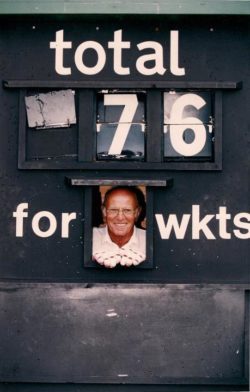
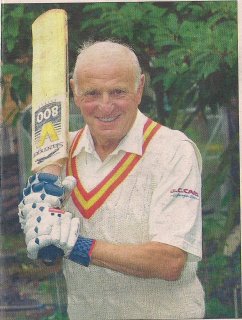
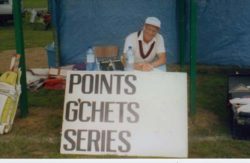
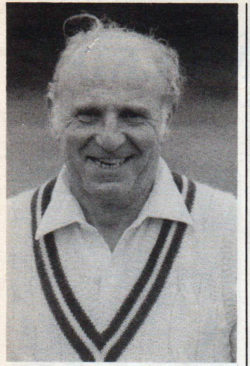
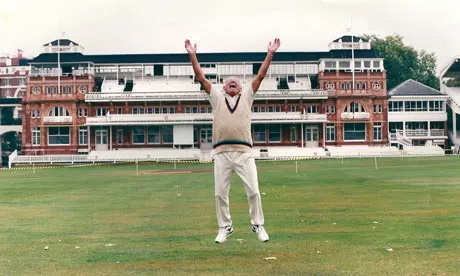
Guardian Obituary written by Clyde Jeavons